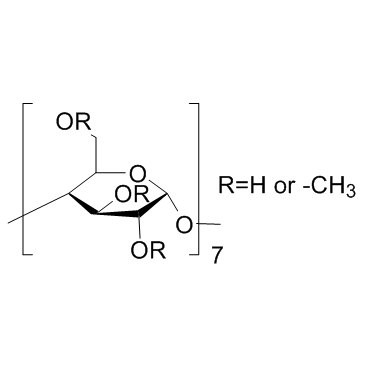Methyl-β-cyclodextrin (Methyl-beta-cyclodextrin) (Synonyms: Randomly methylated β-cyclodextrin) |
| رقم الكتالوجGC32697 |
ميثيل-بيتا-سيكلودسترين (Methyl-beta-cyclodextrin) هو سكاريد دائري يحتوي على سبعة وحدات مستخدم لتسليم الأدوية غير المائية بناءً على خاصية تذوب المواد غير القطبية. كما يستخدم ميثيل-بيتا-سيكلودسترين (Methyl-beta-cyclodextrin) بشكل واسع كعامل مخفض للكولسترول. يقلِّصُ مَجْهُولُ الهَوِّءِ التابِعٌ للاستقْبالات التابِعةٌ لبروتَئِین Clathrin بشكل قوى.
Products are for research use only. Not for human use. We do not sell to patients.

Cas No.: 128446-36-6
Sample solution is provided at 25 µL, 10mM.
Methyl-β-cyclodextrin, a cyclic heptasaccharide, is an effective agent for the depletion of cholesterol from cells; also inhibits PEL cell growth with an IC50 of 3.33-4.23 mM.
Cyclodextrins are a family of cyclic oligosaccharides with a hydrophilic outer surface and a lipophilic central cavity. Cyclodextrins molecules are relatively large with a number of hydrogen donors and acceptors and, thus in general, they do not permeate lipophilic membranes. In the pharmaceutical industry, cyclodextrins have mainly been used as complexing agents to increase aqueous solubility of poorly soluble drugs and to increase their bioavailability and stability. Cyclodextrins are used in pharmaceutical applications for numerous purposes, including improving the bioavailability of drugs[2]. Methyl-β-cyclodextrin quickly induces caspase-dependent apoptosis in PEL cells via cholesterol depletion from the plasma membrane. Methyl-β-cyclodextrin inhibits the growth of all PEL cell lines in a dose-dependent manner. The IC50 is 3.33-4.23 mM in each cell line[1]. Methyl-b-cyclodextrin is a highly water soluble cyclic heptasaccharide consisting of a β-glucopyranose unit, has been reported as the most effective agent for the depletion of cholesterol from cells among the various cholesterol-depleting agents[1].
In a PEL xenograft mouse model, methyl-b-cyclodextrin significantly inhibits the growth and invasion of PEL cells without apparent adverse effects. Methyl-b-cyclodextrin-treated mice appears to be healthy, whereas non-treated mice has a distended abdominal region. The body weights of control are significantly higher than those of M-b-CyD treated mice. Methyl-b-cyclodextrin-treated mice has a significantly lower volume of ascites than that of non-treated mice[1]. Studies in both humans and animals have shown that cyclodextrins can be used to improve drug delivery from almost any type of drug formulation. Currently, there are approximately 30 different pharmaceutical products worldwide containing drug/cyclodextrins complexes in the market[2].
[1]. Gotoh K, et al. The antitumor effects of methyl-β-cyclodextrin against primary effusion lymphoma via the depletion of cholesterol from lipid rafts. Biochem Biophys Res Commun. 2014 Dec 12;455(3-4):285-9. [2]. Tiwari G, et al. Cyclodextrins in delivery systems: Applications. J Pharm Bioallied Sci. 2010 Apr;2(2):72-9.
Average Rating: 5 (Based on Reviews and 17 reference(s) in Google Scholar.)
GLPBIO products are for RESEARCH USE ONLY. Please make sure your review or question is research based.
Required fields are marked with *



